Related Research Articles

Mozambique, officially the Republic of Mozambique, is a country located in southeastern Africa bordered by the Indian Ocean to the east, Tanzania to the north, Malawi and Zambia to the northwest, Zimbabwe to the west, and Eswatini and South Africa to the southwest. The sovereign state is separated from the Comoros, Mayotte and Madagascar by the Mozambique Channel to the east. The capital and largest city is Maputo.
Mozambique was a Portuguese colony, overseas province and later a member state of Portugal. It gained independence from Portugal in 1975.

Zambia, officially the Republic of Zambia, is a landlocked country at the crossroads of Central, Southern and East Africa, although it is typically referred to as being in Southern Africa at its most central point. Its neighbours are the Democratic Republic of the Congo to the north, Tanzania to the northeast, Malawi to the east, Mozambique to the southeast, Zimbabwe and Botswana to the south, Namibia to the southwest, and Angola to the west. The capital city of Zambia is Lusaka, located in the south-central part of Zambia. The nation's population of around 19.5 million is concentrated mainly around Lusaka in the south and the Copperbelt Province to the north, the core economic hubs of the country.

Portuguese Mozambique or Portuguese East Africa were the common terms by which Mozambique was designated during the period in which it was a Portuguese colony. Portuguese Mozambique originally constituted a string of Portuguese possessions along the south-east African coast, and later became a unified colony, which now forms the Republic of Mozambique.

The Zambezi River is the fourth-longest river in Africa, the longest east-flowing river in Africa and the largest flowing into the Indian Ocean from Africa. Its drainage basin covers 1,390,000 km2 (540,000 sq mi), slightly less than half of the Nile's. The 2,574-kilometre-long (1,599 mi) river rises in Zambia and flows through eastern Angola, along the north-eastern border of Namibia and the northern border of Botswana, then along the border between Zambia and Zimbabwe to Mozambique, where it crosses the country to empty into the Indian Ocean.
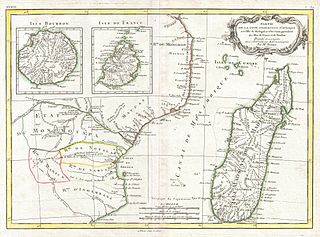
The Kingdom of Mutapa – sometimes referred to as the Mutapa Empire, Mwenemutapa, – was an African kingdom in Zimbabwe, which expanded to what is now modern-day Mozambique.
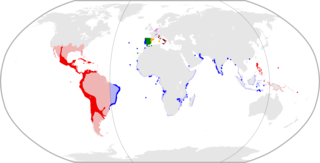
Spanish America refers to the Spanish territories in the Americas during the Spanish colonization of the Americas. The term "Spanish America" was specifically used during the territories' imperial era between 15th and 19th centuries. To the end of its imperial rule, Spain called its overseas possessions in the Americas and the Philippines "The Indies", an enduring remnant of Columbus's notion that he had reached Asia by sailing west. When these territories reach a high level of importance, the crown established the Council of the Indies in 1524, following the conquest of the Aztec Empire, asserting permanent royal control over its possessions. Regions with dense indigenous populations and sources of mineral wealth attracting Spanish settlers became colonial centers, while those without such resources were peripheral to crown interest. Once regions incorporated into the empire and their importance assessed, overseas possessions came under stronger or weaker crown control. The crown learned its lesson with the rule of Christopher Columbus and his heirs in the Caribbean, and they never subsequently gave authorization of sweeping powers to explorers and conquerors. The Catholic Monarchs' conquest of Granada in 1492 and their expulsion of the Jews "were militant expressions of religious statehood at the moment of the beginning of the American colonization." The crown's power in the religious sphere was absolute in its overseas possessions through the papacy's grant of the Patronato real, and "Catholicism was indissolubly linked with royal authority." Church-State relations were established in the conquest era and remained stable until the end of the Habsburg era in 1700, when the Bourbon monarchs implemented major reforms and changed the relationship between crown and altar.

Zambo or Sambu is a racial term historically used in the Spanish Empire to refer to people of mixed Indigenous and African ancestry. Occasionally in the 21st century, the term is used in the Americas to refer to persons who are of mixed African and Indigenous American ancestry. Historically, the racial cross between enslaved Africans and Amerindians was referred to as a zambayga, then zambo, then sambo.
The lançados were settlers and adventurers of Portuguese origin in Senegambia, Cabo Verde, Guinea, Sierra Leone, and other areas on the coast of West Africa. Many were Jews—often New Christians—escaping persecution from the Portuguese Inquisition. Lançados often took African wives from local ruling families, securing protection and advantageous trading ties. They established clandestine trading networks in weaponry, spices, and slaves. This black market angered the Portuguese Crown by disrupting its ability to collect taxes.
Colonial war is a blanket term relating to the various conflicts that arose as the result of overseas territories being settled by foreign powers creating a colony. The term especially refers to wars fought during the nineteenth century between European armies in Africa and Asia.
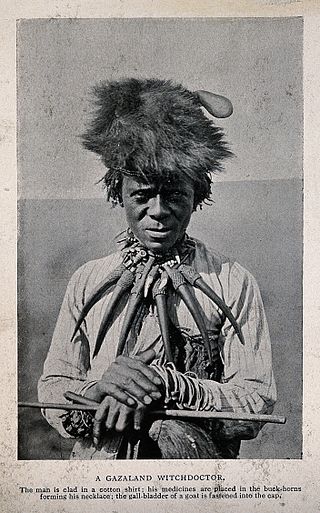
Gazaland is the historical name for the region in southeast Africa, in modern-day Mozambique and Zimbabwe, which extends northward from the Komati River at Delagoa Bay in Mozambique's Maputo Province to the Pungwe River in central Mozambique.
Soshangana KaZikode, born Soshangana Nxumalo, was the Founder and the Monarch of the Gaza Empire, which at the height of its power stretched from the Limpopo river in southern Mozambique up to the Zambezi river in the north. Soshangana ruled over the Gaza state from 1825 until his death in 1858. Soshangana was also known by the name of Manukosi.
A prazo was a large estate leased to colonists, settlers and traders in Portuguese Africa to exploit the continent's resources. Prazos operated like semi-feudal entities and were most commonly found in the Zambezi River valley.

The 1890 British Ultimatum was an ultimatum by the British government delivered on 11 January 1890 to the Kingdom of Portugal. The ultimatum forced the retreat of Portuguese military forces from areas which had been claimed by Portugal on the basis of historical discovery and recent exploration, but which the United Kingdom claimed on the basis of effective occupation. Portugal had attempted to claim a large area of land between its colonies of Mozambique and Angola including most of present-day Zimbabwe and Zambia and a large part of Malawi, which had been included in Portugal's "Rose-coloured Map".
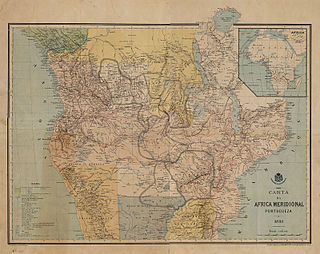
The Pink Map, also known in English as the Rose-Coloured Map, was a map prepared in 1885 to represent Portugal's claim of sovereignty over a land corridor connecting their colonies of Angola and Mozambique during the Scramble for Africa. The area claimed included most of what is currently Zimbabwe and large parts of modern Zambia and Malawi. In the first half of the 19th century, Portugal fully controlled only a few coastal towns in Angola and Mozambique. It also claimed suzerainty over other almost independent towns and nominally Portuguese subjects in the Zambezi valley, but could rarely enforce its claims; most of the territory now within Angola and Mozambique was entirely independent of Portuguese control. Between 1840 and 1869, Portugal expanded the area it controlled but felt threatened by the activities of other powers.
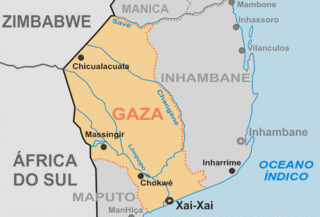
The Gaza Empire (1824–1895) was an African empire established by general Soshangane and was located in southeastern Africa in the area of southern Mozambique and southeastern Zimbabwe. The Gaza Empire, at its height in the 1860s, covered all of Mozambique between the Zambezi and Limpopo rivers, known as Gazaland.

The Sena people are a Bantu ethnolinguistic group with origins in northwestern region of Mozambique in Tete Province, Manica Province, Sofala Province and Zambezia Province. They are also found in Malawi and Zimbabwe near their respective borders with Mozambique.
Chikunda, sometimes rendered as Achicunda, was the name given from the 18th century onwards to the slave-warriors of the Afro-Portuguese estates known as Prazos in Zambezia, Mozambique. They were used to defend the prazos and police their inhabitants. Many of the chikunda were originally chattel slaves, raised to the status of soldiers, traders or administrators of parts of the prazo as a client or unfree dependent.

Slavery was practiced in Colombia from the beginning of the 16th century until its definitive abolition in 1851. This process consisted of trafficking in people of African and indigenous origin, first by the European colonizers from Spain and later by the commercial elites of the Republic of New Granada, the country that contained what is present-day Colombia.
Allen Isaacman is an American historian specializing in the social history of Southern Africa. He is a Regents Professor of History at the University of Minnesota. In 2015, he was inducted into the American Academy of Arts and Sciences.